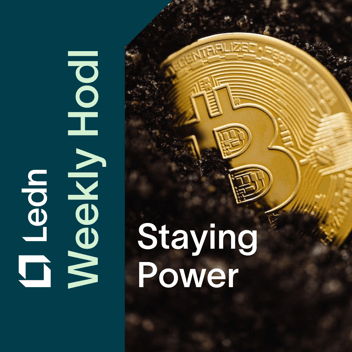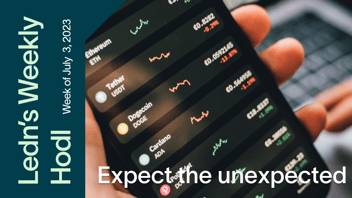Weekly Hodl: Argentina: Tourists over locals
.png?width=1080&height=1080&name=IG%20BEC%20(7).png)
Ledn’s Weekly Hodl: Tourists over locals in Argentina
Week of Monday June 19th
Start earning up to 9% APY on your crypto with a Ledn Savings Account.
Announcement .
Introducing “Collateral Rebalancing”. You can now rebalance your loan collateral when bitcoin price increases! Learn more here.
Bitcoin Market Analysis
Bitcoin closed last week down -1.45% at $30,168. Spot traded volume was on par with what we’ve seen since March. From a technical perspective, this is now the third consecutive weekly close over $30k, which bodes well for a potential continuation of the current rally.
Looking at the Bitcoin Futures markets, we see that the funding rates on perpetual futures are close to 0% on average, suggesting that short and long positions are balanced at the time of writing. In terms of the curve, it still shows a healthy contango with prices moving higher in further out maturities.
In terms of catalysts, the next interest rate decision from the Federal Reserve is scheduled for July 26th, 2023. And next week we’ll start getting corporate earnings reports from U.S. equities, which could move markets.
In terms of the Bitcoin spot ETF catalysts, the next key dates will be August 13th - which is the 2nd deadline for the Ark 21 Shares Bitcoin ETF. Beyond that, September 1st is the first deadline for the Bitwise Bitcoin ETP Trust, and September 2nd is the first deadline for the Blackrock iShares Bitcoin Trust.
Our Weekly Blog: Tourists over locals in Argentina
If you’ve visited Argentina recently, you’ve probably been told to bring U.S. cash. Argentina’s currency is hyperinflating, but the Central Bank refuses to admit so. The “official” exchange rate is 275 Pesos/USD - meanwhile the “blue rate”, or what you would get for your cash dollars on the street is 498 Pesos/USD. Over the last 6 months the Argentine Central Bank has embarked on a series of maneuvers to try to contain the peso’s slide - including offering a better FX rate to foreign tourists. In today’s essay we examine the impact of recent decisions.
Trust Issues
Argentinians have always had trust issues with their currency - and for good reason. Their currency has collapsed and been renamed 4 times since 1970. In 1992 Argentine Peso established a peg to the U.S. dollar - which lasted until January 2002, when the peg broke and the Central Bank could no longer honour it, and made an overnight change to a floating currency. The Peso went from 1 Peso per USD, to 4 Pesos per USD - meaning Argentine savers lost 75% of their value.
Over the last 21 years, the Peso has continued to devalue vs. the U.S. dollar. As mentioned above, the “blue” exchange rate is roughly 500 ARS/USD - which means it has lost 99.2% of its value since 2002. The Central Bank has had to intervene repeatedly to contain the collapse. Can you spot when the Peso stopped trading freely on the chart below?
Central Bank Interventions
To list all of the Argentine Central Banks interventions and foreign exchange regimes would take ages. In simple terms, the crux of the matter boils down to this: The Argentine people don’t believe in the government’s ability to manage its budget, and assume they will continue printing Pesos and continue to devalue the currency until they have to wipe more zeroes and re-issue the currency (the Venezuela playbook).
This mistrust by the Argentine people results in a supply and demand imbalance for Pesos and Dollars. Nobody wants to hold Argentine Pesos - everyone wants U.S. dollars. In a free-floating market, that would result in the peso losing value until it reaches equilibrium - a price at which enough U.S. dollar supply comes in, and the bleeding stops. However, if the Central Bank were to allow the Argentine Peso to float freely, it would show that the Argentine economy is doing terribly. Instead, they decide to set an exchange rate that _they_ believe is fair, and limit the amount of U.S. dollars that any citizen can purchase at that rate.
This does 2 things: 1) it allows the Central Bank to show the world that it’s currency is “stable” - and that it’s “not hyperinflating”. And 2) a preferential ARS to USD rate can be offered to friends and allies of the government, as an instant path to riches (those who access preferential rates are able to purchase U.S. dollars at 275 Pesos/USD and sell their imported products at a market value of 498 Pesos/USD - like magic!).
Dollar Blue
Let’s say you’re in Argentina and just got paid in Pesos - which you know are losing value at more than 100% inflation per year. Do you sit there and accept that you’ll be poorer by the hour? No. They go and find U.S. dollars any way they can. This creates a secondary market that sets its own “unofficial” exchange rate - the rate at which people in the open market are willing to sell their U.S. dollars. Of course, this rate is much higher than the supposed “official” exchange rate that the Central Bank quotes but that only a select group of friends - sorry, people - get access to.
The difference between the official rate and the “blue” rate has roughly remained at 100% since 2019. That is, if the official rate is 100 ARS/USD, the blue rate would be 200 ARS/USD. If we were to measure Argentina’s inflation rate as per the Dollar Blue exchange rate, the data would be 2X worse than what’s “officially reported”.
What do Central Banks do to bridge this gap? The answer to their problems is to be able to buy more U.S. dollars at a rate that they can turn around and sell to the Argentine economy. How do they do this? They look at people that would benefit greatly from a better “official” rate - and they create “special exchange rates” for them.
For example, the Central Bank knows that all exporters are hurt by the official rate, because it underpriced their sales in Peso terms. To create an incentive for them, see “Soy Dollar” example below:
The “Tourist Dollar”
Another cohort impacted by games played with the FX rate are foreign tourists. Because all purchases made through banks are processed at the “official rate” and the economy is priced at the “blue” rate, tourists that wanted to pay $1 for a coffee, would end up being charged for $2 on their credit cards. This made Argentine tourism incredibly expensive. But tourists also found a way around it - they stopped using their cards and would instead bring U.S. cash to make their money “go further”.
This created 2 issues for the Central Bank: 1) it reduces the amount of U.S. dollars that it can purchase through its banking system, because nobody wants to spend their USD at an exchange rate that gets you half the Pesos. 2) When tourists bring U.S. cash into the Argentine economy, it feeds the supply of U.S. dollars and increases the use of the same within Argentine society.
Central Bankers being the brilliant bunch that they are, came up with a solution. Let’s improve the exchange rate that we offer foreign tourists.
The new special rate for foreign tourists is offered as the “Tourist” dollar, and it tradesat an even better rate than the “Blue” or open rate.
Official USD/ARS exchange rate: 275 ARS
Tourist USD/ARS exchange rate: 551 ARS
“Blue” or Open USD/ARS exchange rate: 499 ARS
In other words, tourists that spend with their foreign cards, can get a better rate to buy pesos than local Argentinians selling their hard earned U.S. dollars.
Let’s put the fact that a Central Bank is offering a better rate to foreigners than to its own people aside, and see what the most recent maneuvers have done for the Peso.
Saving Private Peso?
The Tourist Dollar exchange rate was announced on November 4th, 2022, and came into effect on Jan 1st, 2023.
Has it helped stop the Peso’s slide?
The answer is no. Since January 2023, the peso has gone from 348 ARS/USD to 499 ARS/USD - meaning it has lost 30% of its value in 6 months.
But the Central Bank hasn’t stopped trying to play games. Three months ago it announced more special exchange rates for wine producers.
Closing thoughts
Offering these “special exchange rates” to narrow segments of the economy won’t solve the problem. The real solution is to allow all economic participants to trade in and out of the Argentine Peso at a free floating exchange rate, dictated by the market.
However, the Central Bank won't allow this. Why? Because there are more people trying to sell pesos than to buy pesos. And that will keep pushing the exchange rate down until the government gets their act together.
Needless to say, Argentines are smart, and in the face of hyperinflation they are running towards bitcoin and stablecoins in the absence of U.S. dollars.
In these economic environments, it’s better to hodl than to hope.
Notice for Canadian Residents: As of January 4, 2023, Canadian clients will no longer be able to take out new B2X loans.
As of February 1, 2023, Canadian clients will no longer be able to open a new BTC or USDC Savings Account, deposit BTC or USDC to existing Savings Accounts or earn yield on any existing BTC or USDC Savings Account balances.
Notice for U.S. Residents: Effective March 1, 2023, U.S. clients will not earn interest on any BTC and/or USDC balance in their Savings Accounts and/or Legacy Savings Accounts.



